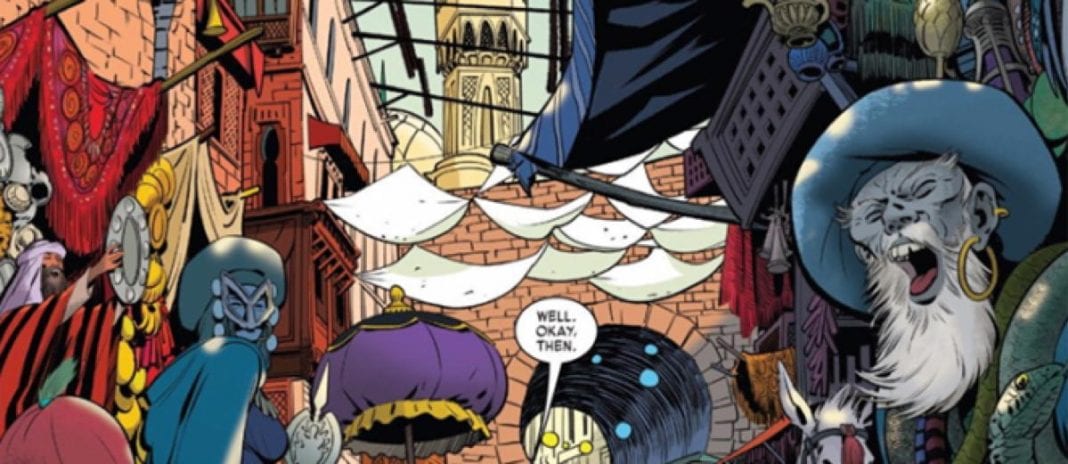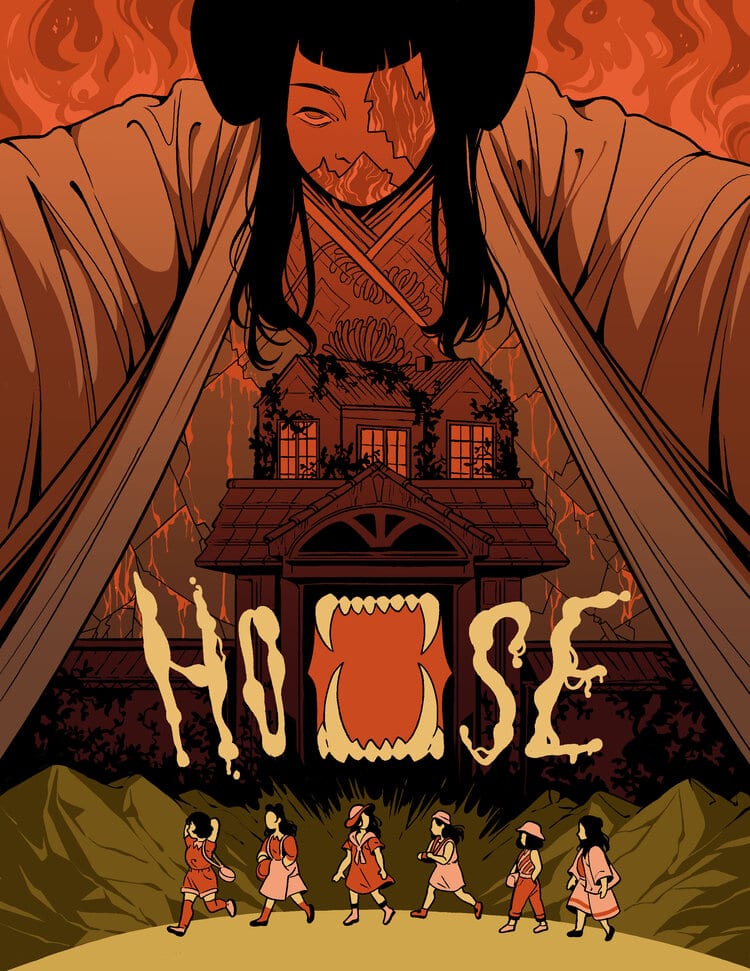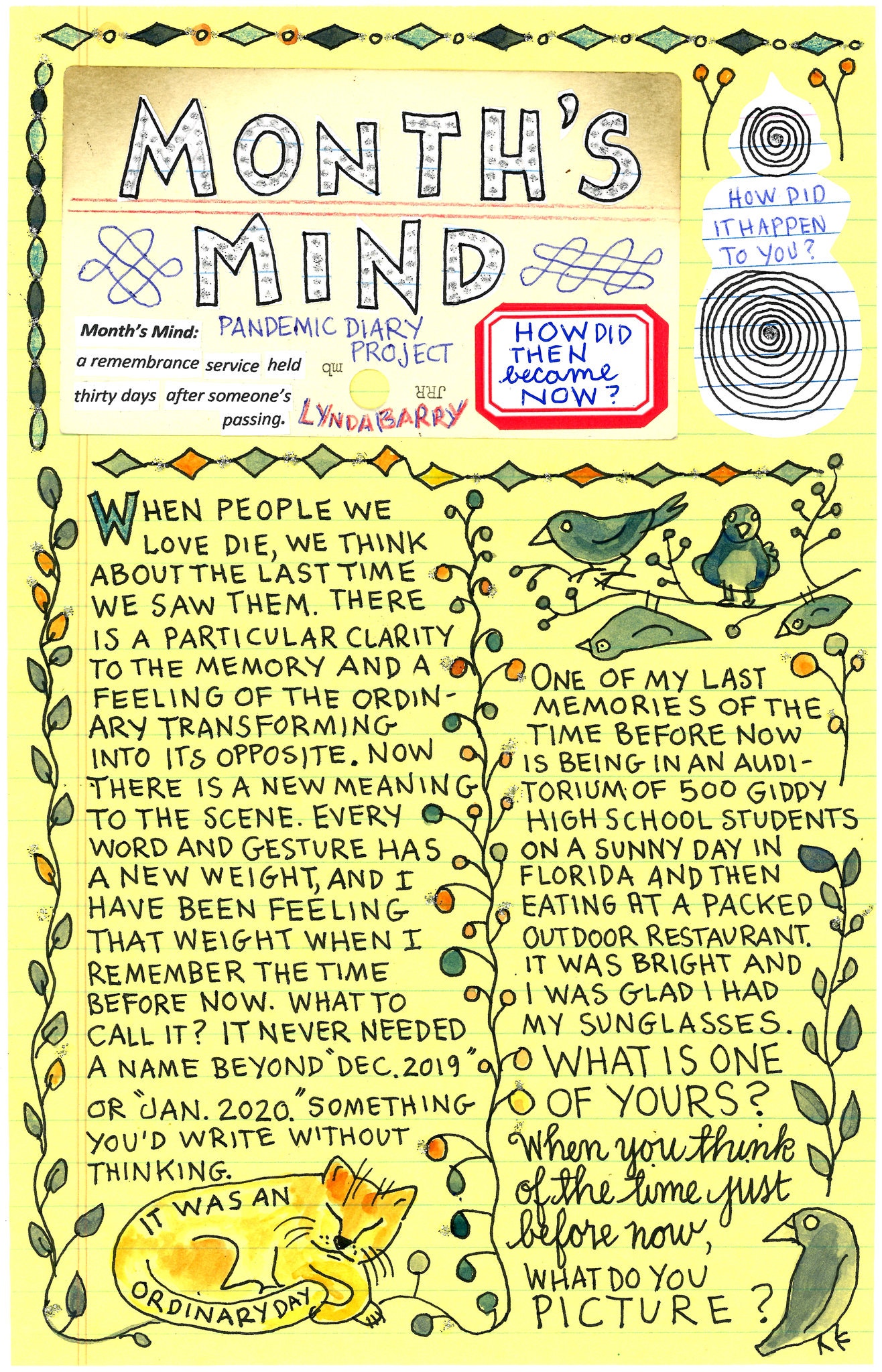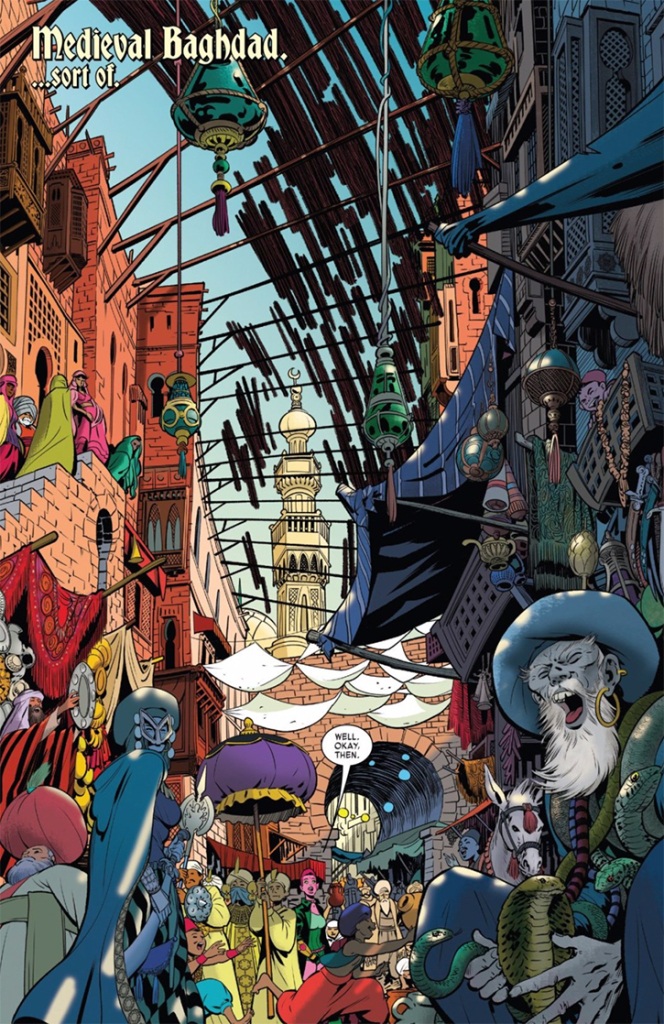§ Nice art: Rosemary Valero-O’Connell opened a web shop with beautiful prints and half the money goes to COVID relief – a great deal except, annoyingly, all the signed copies of Don’t Go Without Me are sold out already!
https://twitter.com/hirosemaryhello/status/1257740897854390273
§ Before attempting a slapdash round-up of linkage, I would like to salute Clark Burscough whose weekly links column for TCJ.com includes every f*cking link to every damn thing that happened in the previous week. I mean EVERY THING. Why are you even reading this? Just go to THAT link and you will not need Netflix ever again. I’ll even steal a paragraph to pass along as news:
• On the creator side of things, ShortBox have announced the first five recipients of their micro-grants program; Perfectly Acceptable Press have announced the three recipients of their Pumpkin’s Remote Residency program; and Koyama Press have showcased another of their …Provides’ project grant recipients. All creators worth checking out and giving a follow on social media, if you’re so inclined.
Burscough must have some kind of super power. I hear he’s joining the New Mutants as “Linker”.
§ Reminder: that Moon Girl and Devil Dinosaur cartoon is coming to Disney and it has at least one director now:
https://twitter.com/absoliutely/status/1257422973755109380
§ If you need a break from COVID-19 relief, here’s a way to help out artist Shane Davis with a very unexpected legal problem in attempting to get back some of his original art, which he accidentally left in a car he sold. But the buyer didn’t want to cooperate:
After I was alerted to the taking, I contacted the man claiming to be in possession of my artwork, and demanded its return. Instead of offering to return the artwork, he threatened to burn it if I reported it as stolen. He then tried to convince me to give him my home address, but I eventually met him in a public place, hoping to arrange the safe return of my artwork. When I met him in person, he tried to convince me to pay him for the return of MY OWN ARTWORK. After I got back some of the artwork during our meeting, he grabbed me around the neck and placed me in a “rear naked chokehold” (his words) for nearly two minutes. As a result of this, I’ve had to see a chiropractor for sustained back injuries. I was also referred to a specialist to get an MRI done for my back. All of these medical bills have been out-of-pocket expenses for me and have been a huge financial burden.
Davis is going to small claims court to get his artwork back and needs money for that battle as well. Man, this all sucks.
§ Heavy Metal has been very active even during the shutdown, and Rob Salkowitz talks to new publisher Matt Medney about the Virus imprint and more.
The new team has announced a dramatic set of changes. The flagship publication, Heavy Metal, has returned to the shelves of comic shops, newsstands and specialty retailers on a regular basis, as opposed to the erratic and unpredictable schedule that it had slipped into previously. It retains the high-gloss magazine anthology format, with a new emphasis on ongoing series and company-owned IP. In addition, the company is launching several comic series based on ongoing characters, including Taarna, the iconic warrior princess best known from her appearance in the 1981 animated Heavy Metal movie, and Nelson, a skeletal zombie warrior.
Medney and Erwin revealed exclusively to Forbes that George C. Romero, filmmaker and son of zombie godfather George A. Romero (Night of the Living Dead), is not only doing a comic-based prequel to his father’s famous film called Rise, but will be leading the first story arc in the Nelson universe, titled Cold Dead War. Heavy Metal also recently announced the launch of a new imprint with the timely name Virus, featuring creator-owned original stories from industry professionals like Ron Marz and Bob Fingerman, distributed direct to consumers via the web and print-on-demand. Medney emphasized that this new distribution model was both fairer to creators (“creators are going to be paid from the first dollar of sales”) and resilient to the challenges of a comics retail and distribution market that has completely collapsed in the wake of the pandemic.
§ At this point it would be more newsworthy if some kind of public gathering was GOING to take place, but for the record, local officials have ruled that there will be no Dragon Con this year.
Atlanta’s City Council voted Tuesday to make major changes to large-scale events for the rest of the year. City leaders have decided not to issue permits for things like Atlanta Pride or the Dragon Con parades.
§ Lynda Barry explains how to journal during a pandemic. I wish I head read this seven weeks ago.
§ So how are Lunar and UCS doing distributing comics to shops? David Harper looks at the first week and retailer reactions.
But amongst all of those, one main topic stood out: was DC’s gambit worth it? Was it worth the publisher risking its long-term position in the direct market and relationship with retailers for what effectively amounts to three weeks of lead time on everyone else? It’s complicated, but ultimately, there’s a short answer and a long one. As per usual, we’re going to take the long way there, as we explore that question to see what we can figure out.
A shorter version: A modest number of shops signed up but it seems to have gone okay, even if no one knows where it is going.
§ Is there still good solid comics scholarship? Why yes! Adrienne Resha on Exiles by Ahmad and Rodríguez for The Middle Spaces:
In 1938, Jerry Siegel and Joe Shuster’s Superman debuted in the pages of Action Comics #1, ushering in a genre distinct from, but in debt to, science fiction: the superhero. With characters like Batman in 1939 and Wonder Woman in 1941, Golden Age (1930s to 1950s) superhero characters functioned as variations on the Superman prototype. Twenty-five years after Superman, during the Silver Age (1950s to 1970s), Stan Lee and Jack Kirby brought the X-Men into the Marvel universe. Unlike Superman or Wonder Woman, both born with phenomenal powers, the original five X-Men came into their powers at or around puberty. Not functions of alien or Amazonian genetics, mutants’ powers are caused by variations on human genes. These mutations are simultaneously random and specific. Mutations like telepathy and transmutation are random insofar as they randomly occur in the comics, Jean Gray developing the former and Bobby Drake the latter without any apparent disposition, yet specific insofar as the creators chose certain mutations for certain mutants. Jean Gray (Marvel Girl), Bobby Drake (Iceman), Scott Summers (Cyclops), Warren Worthington III (Angel), and Hank McCoy (Beast) are each variations of the Superman prototype. They are each adaptations.
Resha is also the author of a paper on what she calls “The Blue Age of Comics”
But superhero comics aren’t just fables, they’re speculative fiction: they allow creators and readers to imagine alternative power structures. These comics, especially those made by creators of marginalized identities during the contemporary period—defined by social media and the digitization of comic books—that I have termed the Blue Age (2010s to present), aren’t just about good versus evil. They imagine what might happen if power was more evenly distributed. Exiles, in particular, is about power: not just mutant abilities but systemic power, especially if one reads team books as arguments for collective action, but that’s a topic for another essay. Exiles is a narrative mutant because in it there is as much evidence of where it comes from as there is evidence that the superhero genre is evolving.
§ Meanwhile it seems that coloring books are making a comeback according to Karen Raugust’s survey of what kind of kids books sell in mass market outlets during a massive pandemic. MASS MARKET remember that?
Mass retailers, from Walmart and Target, to supermarkets, drug stores, the dollar/value channel, and wholesale price clubs, have remained open during the pandemic and continue to bring in enormous foot traffic. Customers are not only picking up essentials like food and pharmacy items, but also children’s books, with publishers reporting strong sales across mass channels. Educational and coloring and activity titles lead the way, but increases have also been noted for titles outside of these categories.
§ Also at PW, Claire Kirch looks at the efficiency of those virtual author tours:
Ever since early March, when the nation went into lockdown due to the Covid-19 outbreak, independent booksellers have been tweaking their business models in an attempt to remain solvent. And in doing so, a growing number have turned to hosting virtual author events. There is a consensus among several indie booksellers contacted by PW that virtual events are more time intensive than in-store events, when factoring in how long it takes to set up the event as well as process and ship orders. And all of these booksellers noted that though virtual events pull in viewers and increase visibility for stores, it can be difficult to convert those viewers into paying customers.
§ Going back to the movies. What ever happened to Josh Trank, the troubled director whose Fantastic Four movie basically killed the franchise for a while? This excellent but lengthy – must be about 10,000 words – profile explains.
The race to book Trank ended in late 2012 with an offer from Fox to direct Fantastic Four. In the mid-2000s, a pair of lighthearted Fantastic Four films led by Jessica Alba and Chris Evans failed to break through in a zeitgeist captured by Christopher Nolan’s gritty reinvention of Batman. Fox hoped that a modern sensibility could take the property in a new direction, despite veterans like I Am Legend writer Akiva Goldsman and the team behind 2011’s Thor being unable to make it work. Trank voiced his interest, and though Fox executives offered him the chance to pursue something original, the Marvel movie “felt like the most rebellious thing to do,” the director said. His take on the material made him confident. A company buying into his hype made him bullheaded. Fox didn’t want to make another Fantastic Four movie — it wanted to make Josh Trank’s Fantastic Four movie.
Trank is back this month with a project that seems better for him, Capone starring Tom Hardy, coming to VOD.
§ AND THERE WAS REJOICING! The all time great cinematographer (and Beat icon) Roger Deakins and his wife James are doing a podcast!
Attention, everyone – the GOAT has a podcast. Oscar-winning cinematographer Roger Deakins has started a podcast with his wife and collaborator James Deakins, appropriately titled Team Deakins. The show launched last week and has already released six episodes as of yesterday, which means you already have a few hours of in-depth conversations about filmmaking to dive into.
But… what the heck…are you telling me The Great One already had a message board where he chats with readers and answers questions like What are the best screenplays you’ve ever read? My life has been such a waste.
§ Star Wars Day passed mostly uncelebrated in this household, a desperate bid to go out and buy tortilla chips without catching a deadly disease taking up much of the day, but I did read about 57 Things We Learned from Rian Johnson’s ‘Star Wars: The Last Jedi’ Commentary, because the movie is so popular and beloved.
35. “I was very conscious of kind of the history of scoundrels in the Star Wars universe,” he says, adding that audiences have been conditioned to expect that they will always come around in the end and do what’s right. “With DJ (Benicio Del Toro) I knew that I didn’t want that to happen.”
and SECRETS OF THE MOVIES – wide angle shots!!!
46. Ridley and Driver did an immense amount of training for their big shared fight against the Praetorian guards, and their efforts paid off in that Johnson didn’t have to use long lenses or editing trickery to conceal their inadequacies or the faces of stunt performers. He was able to shoot wide and show the two of them actually doing the fights.
I never thought I would say this but 100% honestly…I think The Last Jedi is the new Star Wars movie I will watch more than any other.
§ So it’s come to this: Korean baseball in the middle of the night. I’ll take it – especially since there is a team called the SK Wyverns. A wyvern being a sort of dragon that has only two legs and not four like a regular dragon. Despite this, the players seem to have four limbs, as do the mascots. Bring on the merch. I’m ready.













Matt Singer wrote an essay noting that a close viewing of THE EMPIRE STRIKES BACK shows that Rian Johnson was faithful to Luke Skywalker’s character. Luke was a self-pitying screw-up in EMPIRE (and the original STAR WARS) and Johnson emphasized that aspect of the character. He just wasn’t the flawless, invincible superhero that immature fans have created in their minds.
Comments are closed.